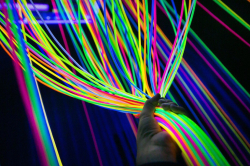Over the holidays, the museum will host creative workshops: visitors can try their hand at making colored-glass mosaics, stained-glass panels, thaumatropes, flip images, Gardner dragon illusions, and “disappearing” images. Workshops will be open to kids and adults alike! Prices start from 100 rubles and the workshop schedule can be found here (in Russian).
On January 3-8, the museum will be open from 11 am to 9 pm daily (the ticket office closes at 8 pm). The guided tour schedule is available on the official website (in Russian). ITMO staff and students enter for free. Adult tickets are 400 rubles, while tickets for kids and the elderly are 300 rubles.

Glass hall. Photo by Dmitry Grigoryev / ITMO.NEWS
New year – new exhibits
The new exhibition Angel of Peter and Paul Cathedral is dedicated to the 300th anniversary of one of the city’s main attractions. The main exhibit is a full-scale hologram of the angel’s head, recorded in 1995 when the cathedral’s weather vane was taken down for restoration. Also on display are photographs of the cathedral dating back from the late 19th – early 20th century, as well as 18th-century engravings by Mikhail Makhaev made with camera obscura. The exhibition will be open until May 2025.
Last summer, the museum was gifted one of its most bizarre exhibits: A Turning in Time, a sculpture by local artists Evgeny Dukhovny and Alexandra Yakusheva. Made from granite and glass, the sculpture is a complex structure consisting of a gabbro granite block, a Shoksha quartzite plate, a polished glass ball, cylinder, and a shard that imbues light with various forms and colors.
In the glass hall, visitors will find another testament to Russia’s science and technology: a spaceship porthole made from radiation-resistant glass. Alongside it are the materials that used to serve in place of glass to humanity over the history, such as mica plates and an oxen bladder. Also in the hall are Venetian millefiori glass and a pyramid with an interference coating that separates the light passing through it into the full spectrum – a rainbow. Moreover, on display are the “ingredients” for making this “transparent” material: quartz sand, lead oxide, and furnace charge.

Glass hall. Photo by Dmitry Grigoryev / ITMO.NEWS
To learn more about how light separates into its spectral components, visitors can look at the fish made from CDs. Thanks to scratches on their surface – not seen by the naked eye, but affecting photons – there, too, you can see the rainbow.

The fish made from CDs. Photo by Dmitry Grigoryev / ITMO.NEWS
Feel the full power of optical illusions in the “endless” mine. While it’s actually only a meter deep, if you look inside, you’ll see a giant corridor boring deep into the earth. This effect is achieved by getting an image to reflect in two pieces of glass: a translucent one that lies above the composition and a regular one located below it. This exhibit was designed and assembled by the museum’s specialists. Another special technique for distorting images are catoptric anamorphoses. The colorful blob on the paper can only turn into a clear image when seen with a special cylinder. Among the museum’s collection of these objects, you’ll find hidden images of a squirrel, a queen, her page, and others. This technique was previously used to conceal important information from prying eyes.
For a fun turn of events, drop by the face transformer. This is a glass “mesh” that two people have to look into together. You see your face reflected at you by the mirrors, while through the gaps between them, you see the face of the second person. Spend a couple of minutes there to see what you’d look like with someone else’s nose, eyes, or mouth.

Face transformer. Photo by Dmitry Grigoryev / ITMO.NEWS













